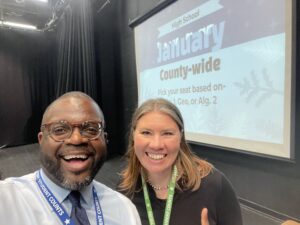Carl Seward, Supervisor of Secondary Mathematics
Kimberly Cordell, Secondary Mathematics Specialist
Programs of Studies
The link above will take you to the webpage that contains the Arlington Public Schools Programs of Studies for both Middle School and High School. In the Programs of Studies, you will find the mathematics courses we offer here in APS.
Secondary Course Progressions
The link above will take you to the webpage that contains both our middle school mathematics progression and our high school mathematics progression.
Resources We Use in Secondary Mathematics
Arlington Public Schools uses the following purchased resources to support the teaching and learning of the Virginia Department of Education Standards of Learning for Mathematics. Textbooks and online text resources are just one aspect of the media and methodology used to create rich instructional experiences for our students.
- Savvas Realize
- DeltaMath
- Bridges (Intervention)
- Do the Math (Intervention)
Five Process Standards of Mathematics (Developed by the National Council of Teachers of Mathematics and Promoted by the Virginia Department of Education)
Mathematical Problem Solving
Students will apply mathematical concepts and skills and the relationships among them to solve problem situations of varying complexities. Students also will recognize and create problems from real-world data and situations within and outside mathematics and then apply appropriate strategies to determine acceptable solutions. To accomplish this goal, students will need to develop a repertoire of skills and strategies for solving a variety of problem types. A major goal of the mathematics program is to help students apply mathematics concepts and skills to become mathematical problem solvers.
Mathematical Communication
Students will communicate thinking and reasoning using the language of mathematics, including specialized vocabulary and symbolic notation, to express mathematical ideas with precision. Representing, discussing, justifying, conjecturing, reading, writing, presenting, and listening to mathematics will help students to clarify their thinking and deepen their understanding of the mathematics being studied. Mathematical communication becomes visible where learning involves participation in mathematical discussions.
Mathematical Reasoning
Students will recognize reasoning and proof as fundamental aspects of mathematics. Students will learn and apply inductive and deductive reasoning skills to make, test, and evaluate mathematical statements and to justify steps in mathematical procedures. Students will use logical reasoning to analyze an argument and to determine whether conclusions are valid. In addition, students will use number sense to apply proportional and spatial reasoning and to reason from a variety of representations.
Mathematical Connections
Students will build upon prior knowledge to relate concepts and procedures from different topics within mathematics and see mathematics as an integrated field of study. Through the practical application of content and process skills, students will make connections among different areas of mathematics and between mathematics and other disciplines, and to real-world contexts. Science and mathematics teachers and curriculum writers are encouraged to develop mathematics and science curricula that support, apply, and reinforce each other.
Mathematical Representations
Students will represent and describe mathematical ideas, generalizations, and relationships, using a variety of methods. Students will understand that representations of mathematical ideas are an essential part of learning, doing, and communicating mathematics. Students should make connections among different representations – physical, visual, symbolic, verbal, and contextual – and recognize that representation is both a process and a product.
 Contact
Contact  Calendars
Calendars Careers
Careers Engage
Engage  District
District
